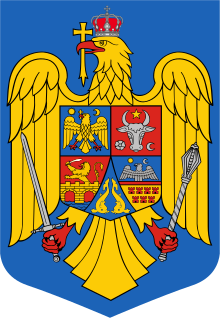1918 Romanian National Assembly election
Elections for 680 of the 1,228 delegates to the National Assembly of Romanians of Transylvania and Hungary took place in Transylvania and neighbouring regions of the Hungarian Democratic Republic inhabited by Romanians between November 20 and December 1, 1918. Called by the Central Romanian National Council, the elections were open exclusively to ethnic Romanians, with women excluded from the process in most of the places. Voting procedure was highly irregular, ranging from universal vote direct vote to indirect elections and even acclamation by local self-proclaimed "Romanian national councils".
Part of a series on the |
|---|
| History of Romania |
 |
|
Post-Revolution |
|
|
History
- November 13–15, 1918 - Negotiations are held in Arad between the Hungarian government of Károlyi Mihály and the Central National Romanian Council (of Transylvania), without reaching any agreement. News about the Belgrade agreement reach the Romanian (Transylvanian) delegation. The Central National Romanian Council retreats from negotiations and decides to hold elections and convey for December 1 [O.S. November 18] 1918 the National Assembly of Romanians from Transylvania and Hungary, and to hand power to the latter.
- November 1918 - During a 12-day interval, elections are held for the National Assembly of Romanians of Transylvania and Hungary. Its 1,228 members are elected 5 each from the electoral districts established in 1910 (600 members in total), and 628 to represent different social, professional and cultural organizations (clergy, teachers' unions, military). The local enthusiasm gains momentum, as demands such as land reform, universal vote, and possible union with Romania are put forward.
- On December 1, 1918 (November 18 Old Style), the National Assembly of Romanians of Transylvania and Hungary, consisting of 1,228 elected representatives of the Romanians in Transylvania, Banat, Crișana and Maramureș, convened in Alba Iulia (Gyulafehérvár) and decreed (by unanimous vote) the Union of Transylvania with Romania
- On December 2, 1918 the High National Romanian Council of Transylvania formed a government under the name of Directory Council of Transylvania (Consiliul Dirigent al Transilvaniei), headed by Iuliu Maniu.[1]
gollark: Or punished lots.
gollark: It's quite plausible that if actually *fully enforced*, the laws of many countries would result in close to their entire populations being imprisoned.
gollark: I have vaguely worried about this, since laws aren't updated to go along with this.
gollark: Arguably revolutions are increasingly less practical because technology makes law enforcement easier.
gollark: Alternatively, just have better grid infrastructure?
See also
- 1917 Bessarabian legislative election
References
External links
This article is issued from Wikipedia. The text is licensed under Creative Commons - Attribution - Sharealike. Additional terms may apply for the media files.